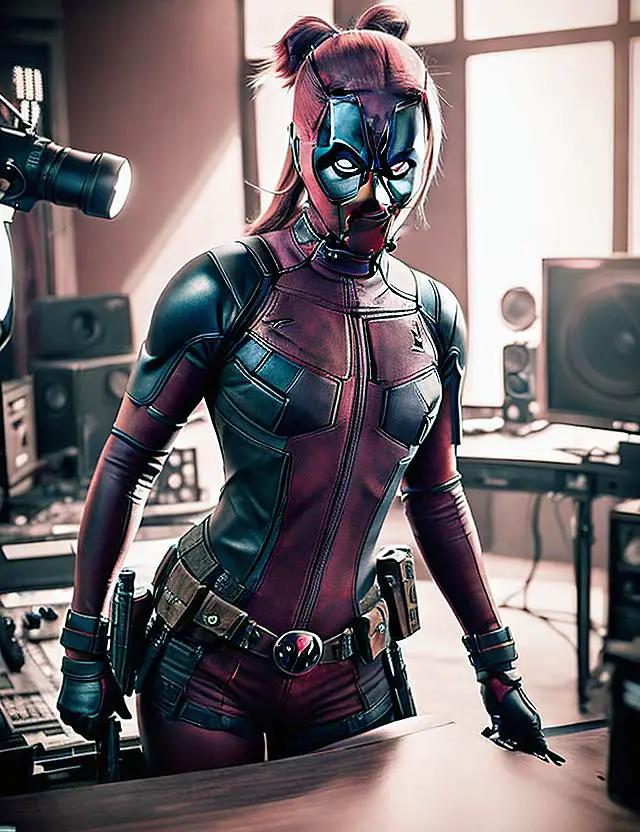Step right into the captivating realm of cosplay armor pattern scaling! As an enthusiast eager to elevate your armor crafting expertise, mastering the art of scaling is indispensable. Scaling your patterns is the magic wand that allows you to tailor existing templates or concoct original designs, ensuring a perfect fit for your unique body dimensions.
In this blog post, we will delve deep into the labyrinth of cosplay armor pattern scaling, unveiling an array of invaluable tools and techniques tailored to sculpt your success. Before we plunge into the captivating details of scaling, let’s unravel why this intricate process is the unsung hero of cosplay armor crafting.
By masterfully scaling your patterns, you can ensure each armor piece melds seamlessly with your physique. To commence your scaling journey, arm yourself with some essential tools and materials
Your trusty measuring tape will play the protagonist in obtaining spot-on measurements of various body contours. Furthermore, tracing paper or any transparent counterpart will aid in transferring and adjusting patterns with pinpoint precision.
In addition, arming yourself with robust pattern transfer techniques can smooth out the scaling process. When it comes to the precision art of cosplay armor pattern scaling, accurate measurements are your loyal knights in shining armor.
Manual pattern scaling can be a labor of love but can be incredibly fulfilling when executed with precision. It’s a process interwoven with basic mathematical maneuvers to tweak each pattern section proportionately in accordance with your measurements.
So, clutch your measuring tape and tracing paper as we embark on this riveting exploration of the craft of cosplay armor pattern scaling. Brace yourself to birth awe-inspiring armor pieces that are a glove-fit and breathe life into your cherished characters!

Mastering the Art of Scaling Your Cosplay Armor Pattern
Scaling your cosplay armor pattern isn’t just a step—it’s an art, a pivotal process in fashioning a costume that’s not just visually striking but also tailormade for your physique. Whether you’re architecting your own armor blueprint or harnessing a pre-existing one, grasping the core of scaling will empower you to render perfect proportions for your cosplay.
So, brandish your measuring tape and tracing paper—we’re about to dive headfirst into the riveting world of pattern scaling! One of the initial considerations when scaling your cosplay armor pattern is the delicate balance of proportions.
Each armor piece should orchestrate a harmonious symphony with the others and with your body. A single piece appearing too minute or too mammoth can disrupt the overall aesthetic.
This is the stage where precise measurements reign supreme! Wield a measuring tape to gauge key areas such as chest circumference, waist size, shoulder breadth, and arm length.
These measurements lay the cornerstone for scaling your patterns. Once you’ve logged all the necessary measurements, it’s time to imprint them onto tracing paper or directly onto your nascent pattern if you’re starting from square one.

Tracing paper serves as a versatile canvas for effortless tweaks and modifications without defacing the original design. It also aids in maintaining precision during the scaling process.
Now onto the thrilling part – the actual pattern scaling! There’s an array of methods at your disposal to scale your cosplay armor patterns: from hands-on manual scaling to digitally savvy scaling tools.
The manual method is a journey through using rulers or grids to amplify or compress each pattern section based on your recorded measurements. It’s a technique that demands a keen eye for detail but offers a gratifying experience if you revel in tactile work.
Alternatively, digital scaling tools present accuracy and convenience right at your fingertips. Leveraging software like Adobe Illustrator or AutoCAD ensures accurate resizing by feeding specific measurements into a program that automatically recalibrates all pattern components.
These tools also come in handy for swift tweaks if any sizing discrepancies emerge during testing. Remember that accuracy in measurements is the linchpin for triumphant pattern scaling.
Be vigilant when measuring your body and cross-verify your numbers before embedding them onto the pattern. Even a trifling error can trigger fitting problems later, brewing frustration during cosplay armor fabrication.
In the next section, we’ll delve into troubleshooting and refining scaling adjustments, as well as testing your scaled pattern for precision. Stay with us to guarantee your cosplay armor slips on like a dream!

Your Toolbox: Essential Instruments and Materials for Scaling
When you’re navigating the terrain of scaling your cosplay armor pattern, armed with the right tools and materials is paramount. These reliable comrades ensure you can resize your pattern to fit your desired measurements with accuracy and efficacy.
So, clutch your measuring tape, tracing paper, and digital scaling tools—we’re about to plunge into the bustling cosmos of pattern scaling! Let’s commence with an old faithful – the measuring tape.
This straightforward yet multipurpose tool is an essential companion for any cosplayer aiming to scale their armor pattern. With a measuring tape at your command, you can gauge various body dimensions such as the chest, waist, hips, and arms.
These measurements lay the groundwork for resizing your armor pattern, paving the way for a flawless fit. Up next is the tracing paper – a secret weapon in the realm of pattern scaling.
This translucent material permits you to effortlessly sketch and transfer your original pattern onto another sheet without marring or modifying it. Deploying tracing paper assures that you have an accurate duplicate of your original design that can be resized without jeopardizing the essence of the original blueprint.
In recent times, digital scaling tools have found favor among cosplayers. These intuitive software programs or apps allow you to digitize your patterns and reshape them with ease on a computer or mobile gadget.
A few clicks or swipes are all you need to adjust the dimensions of diverse elements in your cosplay armor design, sparing you complex computations or potential mistakes that can sneak into manual scaling methods. Whether you’re embracing old-school manual techniques with a measuring tape and tracing paper or leaning into contemporary digital tools for enhanced precision in scaling patterns – these tools are your trusty sidekicks throughout your cosplay voyage.
So gather these materials before you dive into the cutting and shaping of your armor, ensuring accurate measurements, testing patterns for sizing discrepancies, and making necessary adjustments before setting off on the construction process. Your proportionally perfect cosplay armor is on the horizon!

Preparing Your Armor Pattern for Scaling
Before you cannonball into scaling your cosplay armor pattern, you need to prime the pattern for this critical task.
This includes a series of crucial steps aimed at ensuring accuracy and facilitating scaling. Start by scrutinizing your original armor pattern.
Is it crystal clear and well-outlined? Smudges or blurry lines can pave the way for sizing discrepancies later on.
If required, use tracing paper or redraw segments of the pattern to boost its precision. Next, ascertain if your pattern is in sync with your body’s proportions.
Bear in mind that precise measurements are the lifeblood of cosplay armor crafting. Use a flexible measuring tape to evaluate various points on your body, such as chest circumference and arm length.
Contrast these measurements with the ones on your pattern, making any essential adjustments prior to scaling. Now that your original pattern is primed for scaling, it’s time to pick your method of choice: manual scaling or digital scaling tools.
Manual scaling involves expanding or contracting each section of the pattern individually, using either a grid system or freehand. In contrast, digital scaling tools can shave off time and effort by automatically adjusting proportions based on inputted measurements.
Once you’ve chosen your preferred method, assemble all the necessary materials—like graph paper if you’re opting for manual scaling—or set up digital software suitable for the job. Being prepared can smoothen the process and stave off unwarranted disruptions.
By meticulously preparing your armor pattern for scaling, you set a solid foundation for precise adjustments that will amplify both the fit and appearance of your cosplay design. Taking these painstaking steps assures that when it’s time to start cutting and shaping armor pieces based on the scaled patterns, you’re launching from a promising start!
How to Scale Your Armor Pattern
Now that you have your armor pattern ready and the necessary tools at hand, it’s time to dive into the exciting process of scaling. There are a few methods you can use to scale your cosplay armor pattern, but let’s start with the good old manual scaling method. To begin, grab your measuring tape and carefully measure the various sections of your body that correspond to the armor pieces you’re creating.
Take precise measurements of your chest, waist, hips, shoulders, and any other relevant areas. Keep in mind that accuracy in measurements is key here.
Any inconsistencies could result in ill-fitting armor pieces later on. Once you have all your measurements recorded, it’s time to transfer them onto your pattern.
If you’re working with a digital pattern, digital scaling tools can be a real time-saver. However, if you prefer a hands-on approach or have a physical pattern to work with, tracing paper will be your best friend.
Using tracing paper allows you to overlay it onto your existing pattern and trace out new lines according to the scaled measurements. This technique ensures that every detail of the original pattern is preserved while adjusting for proportions accurately.
Make sure to mark reference points on both the original and scaled patterns for easier alignment during construction. After transferring all the necessary measurements onto your pattern using either digital scaling tools or tracing paper, it’s time to move on to cutting and shaping the armor pieces.
Carefully follow along the newly traced lines as you cut out each piece from your chosen material. Remember that precision is crucial here since any errors in cutting may affect how well the armor fits together later on.
Once you’ve cut out all the pieces according to your scaled pattern, it’s time for some cosplay fitting adjustments! Don’t be surprised if some minor tweaks are needed during this stage; fitting armor perfectly on the first try is quite rare.
Test assembling different sections of your armor together and make adjustments as needed until everything aligns and fits your body comfortably. With your scaled pattern, accurate measurements, and adjusted armor pieces in hand, you’re now ready to move on to the exciting part – cosplay armor construction!
Whether it’s foam, worbla, or any other material you’ve chosen for your armor, follow the classic techniques of shaping and detailing each piece to bring your cosplay creation to life. Remember, scaling your cosplay armor pattern is a crucial step that sets the foundation for a successful outcome.
Take the time to ensure accuracy in measurements and make necessary adjustments along the way. With patience and attention to detail during scaling, you’ll soon have a perfectly fitting set of armor that is sure to wow at any convention or event.
Troubleshooting and Adjustments in Scaling
When it comes to scaling your cosplay armor pattern, you may encounter a few bumps along the way.
Sizing inconsistencies can be a real headache, especially if you’re using multiple reference images or working with patterns from different sources. To tackle this issue, it’s crucial to prioritize accuracy in measurements.
Use a measuring tape to ensure precise calculations and take note of any variations that may arise. By paying attention to these details, you’ll be able to identify any discrepancies in your scaling process and make the necessary adjustments.
One handy tool for troubleshooting is tracing paper. This translucent paper allows you to overlay your existing pattern onto a new sheet and make alterations without damaging the original template.
With pattern scaling, it’s essential to maintain accurate proportions in cosplay armor. Tracing paper enables you to experiment with different sizes and shapes while preserving the integrity of your base design.
By visually comparing the scaled patterns with reference images or even on yourself using test fittings, you can pinpoint areas that require adjustment. If you’re tech-savvy or prefer a more precise approach, digital scaling tools can come to your rescue.
These tools allow for quick and accurate adjustments while maintaining proportional integrity throughout the scaling process. They often come equipped with features like automatic recalculations based on specific measurements or pre-set ratios, which simplifies troubleshooting immensely.
Another aspect of troubleshooting involves transferring scaled patterns onto suitable materials for armor construction. Pattern transfer techniques such as tracing directly onto foam or using transfer papers can help bring your scaled design into reality with ease and accuracy.
Once transferred, don’t hesitate to make additional fitting adjustments during the construction phase if needed—cosplay fitting adjustments are part of perfecting the final result. Cutting and shaping armor pieces according to your scaled pattern is another critical step where attention should be paid.
Take time refining edges and curves so that they align seamlessly with each other when assembled into a complete cosplay armor piece. Attention to detail is crucial in cosplay, and even the smallest adjustments can significantly impact the overall appearance.
Troubleshooting and making necessary adjustments are inherent parts of scaling a cosplay armor pattern. By addressing sizing inconsistencies, prioritizing accuracy in measurements, utilizing tracing paper or digital scaling tools, transferring patterns effectively onto materials, and refining the cut and shape of your armor pieces diligently, you’ll overcome any obstacles that come along the way.
Remember that cosplay detailing is an art form that requires patience and precision. Embrace the process and enjoy exploring different methods until you find what works best for you!
Testing and Refining Your Scaled Pattern
Once you’ve successfully scaled your cosplay armor pattern, it’s time to put it to the test. is a crucial step in ensuring that the proportions of your armor will be accurate and that it will fit you perfectly. In this section, we’ll explore some methods and techniques to help you fine-tune your scaled pattern for optimal results.
One of the first things you can do is test your scaled pattern by creating a mock-up of the armor using inexpensive materials like foam or cardboard. This allows you to see how well the pieces fit together and identify any sizing inconsistencies or areas that need adjustment.
By physically wearing the mock-up, you can get a better sense of how the armor will look on your body and make necessary modifications. If you prefer a more precise approach, there are digital scaling tools available that can help streamline the process.
These tools allow you to input measurements directly into a software program, which then automatically scales your pattern accordingly. This method is particularly useful if you’re working with complex designs or intricate details where accuracy in measurements is crucial.
Another technique for refining your scaled pattern involves transferring it onto tracing paper or thin plastic sheets. This allows for easy manipulation of the pieces during cutting and shaping stages as well as making adjustments if needed.
By using these transfer techniques, you can modify specific sections without having to redo the entire pattern, saving both time and effort. Remember that proportions play a significant role in cosplay armor construction.
Take note of how each piece relates to one another when testing your scaled pattern, ensuring that they maintain the correct ratio and alignment with each other. By paying attention to these details during testing, you’ll be able to spot any areas where adjustments are needed and make sure that everything comes together seamlessly in the final product.
In this section about testing and refining your scaled cosplay armor pattern, we explored various methods such as creating mock-ups with inexpensive materials like foam or cardboard, using digital scaling tools for precision, transferring patterns onto tracing paper or thin plastic sheets, and considering proportions in the construction process. These techniques will help you fine-tune your pattern to ensure accuracy and a perfect fit.
In the next section, we will delve further into common challenges and solutions encountered in the process of scaling cosplay armor patterns. Stay tuned!
Using Your Scaled Pattern to Construct Your Cosplay Armor
Now that you have successfully scaled your cosplay armor pattern, it’s time to put it to good use and start constructing your epic armor! Using your scaled pattern is crucial for achieving accuracy in measurements and ensuring that your final cosplay armor fits you like a dream.
Let’s dive into the various steps involved in using your scaled pattern to bring your cosplay vision to life. First and foremost, gather all the materials you will need for constructing your cosplay armor.
This may include EVA foam, worbla, thermoplastics, or any other materials you have chosen for your project. Make sure you have all the necessary tools at hand as well, such as a heat gun, cutting mat, X-Acto knife or scissors, and glue suitable for the materials you’re using.
Once you have everything ready, carefully cut out the individual pieces of your scaled pattern. Use a sharp X-Acto knife or scissors to ensure clean edges on each piece.
Take note of any sizing inconsistencies that may have occurred during scaling; if necessary, make small adjustments with a measuring tape to maintain proportional accuracy while cutting. Next comes the exciting part – shaping and assembling your cosplay armor!
Lay each cut-out piece onto your chosen material (such as EVA foam) and trace around it with a pen or marker. Cut out these traced shapes from the material using the appropriate tools mentioned earlier.
To achieve accurate assembly of your armor pieces, consider transferring any relevant markings from the scaled pattern onto corresponding areas of each cut-out piece. You can use tracing paper or lightly score lines onto the material to mark where certain details should go.
Once all pieces are shaped and marked accordingly, it’s time to carefully glue them together according to their designated positions on the scaled pattern. Whether you’re working with traditional adhesive or heat bonding techniques like with worbla or thermoplastics, take care in aligning each piece accurately for an optimal fit.
Throughout this construction process, don’t hesitate to make any necessary fitting adjustments. Test each armor component against your body to ensure a comfortable and secure fit.
Remember, accuracy in measurements and proportions is essential for achieving an authentic cosplay look. From pattern scaling to cutting and shaping, and finally constructing your cosplay armor, each step plays a vital role in bringing your masterpiece to life.
With careful attention to detail and precision, you can transform a mere pattern into a stunning piece of cosplay artistry. So put on your creative capes, grab those tools, and let the crafting adventure begin!
Common Challenges and Solutions in Armor Scaling
When it comes to scaling a cosplay armor pattern, there are several common challenges that cosplayers may encounter along the way. However, fear not! With some creative problem-solving and a touch of patience, these challenges can be overcome.
Let’s take a closer look at some of the most frequent hurdles faced during armor scaling and explore possible solutions. One common challenge in armor scaling is dealing with sizing inconsistencies.
Sometimes, patterns may not match up perfectly or have variations in proportions. This can lead to frustration when trying to achieve an accurate fit for your cosplay armor.
One solution is to use measuring tape and take precise measurements of your body before starting the scaling process. By ensuring that your measurements are accurate, you can adjust the pattern accordingly to achieve a better fit.
Another challenge arises when cutting and shaping the armor pieces after scaling them. It’s essential to pay close attention to details and ensure that each piece aligns correctly with its counterparts.
Cosplay detailing plays a significant role here, as it helps maintain accuracy in replicating the original design while also making adjustments for fit purposes. Additionally, utilizing tracing paper or digital scaling tools can aid in transferring patterns accurately onto your chosen material.
Additionally, don’t forget about testing cosplay patterns before finalizing your scaled pattern! Testing allows you to identify any potential issues or areas that require further adjustment.
It also gives you an opportunity to see how the scaled pattern looks on you physically so that any necessary tweaks can be made before committing to construction. Accuracy in measurements and proportions is key during this stage since even slight variations can affect how well the armor fits on your body.
While there may be challenges along the way when scaling a cosplay armor pattern, they are all solvable with proper techniques and attention to detail. By addressing sizing inconsistencies through accurate measuring and adjusting patterns accordingly, navigating through cutting and shaping challenges with precision, as well as testing patterns for accuracy in fit and proportionality, you can successfully overcome these hurdles.
Keep in mind that each cosplay project is unique, and it may require some trial and error to achieve the desired outcome. With determination and a bit of creativity, you’ll be well on your way to creating an awe-inspiring cosplay armor ensemble.
The Role of Accuracy in Armor Scaling
When it comes to scaling a cosplay armor pattern, accuracy is paramount. Achieving accurate measurements is crucial in order to ensure that your armor pieces fit together seamlessly and result in a polished final product.
Accuracy in measurements can make the difference between a perfectly tailored cosplay suit and one that looks haphazardly put together. To achieve accuracy, it’s important to utilize the right tools and techniques.
Measuring tape becomes your best friend during this process, allowing you to take precise measurements of your body or the existing pattern you’re working with. Pairing this with digital scaling tools can further enhance accuracy, as these tools provide precise calculations and eliminate human error when resizing patterns digitally.
Another aspect of accuracy lies in maintaining proper proportions within your cosplay armor. Proportions play a crucial role in achieving an authentic look, especially if you’re replicating a character from a specific show or game.
Ensuring that each piece of armor is correctly scaled in relation to the others will contribute to an overall harmonious appearance. Sizing inconsistencies can be a challenge when it comes to scaling patterns accurately.
Keep in mind that patterns may vary between different sources or even within the same source due to different interpretation styles or alterations made by individual cosplayers. Therefore, it’s essential to cross-reference multiple sources and compare their measurements before settling on a final size for each piece of armor.
Accuracy is vital when scaling a cosplay armor pattern as it directly influences how well the pieces fit together and how authentic the final result appears. By using measuring tape, digital scaling tools, and paying attention to proportions while accounting for sizing inconsistencies, you’ll be well on your way to creating beautifully tailored cosplay armor that truly brings your character to life
Conclusion: The Power of Proper Scaling in Cosplay
In the world of cosplay, proper scaling is like the secret ingredient that elevates your craftsmanship to a whole new level. It’s not just about creating a stunning cosplay armor; it’s about ensuring that every piece fits you perfectly and looks proportionate. When you invest time in scaling your pattern accurately, it pays off with a final product that showcases your attention to detail and dedication.
Pattern scaling is an art form in itself. It requires precision and patience, but the results are worth every effort.
Through manual scaling methods or digital tools, you can adjust the size of each component of your cosplay armor to fit your body measurements flawlessly. This step ensures that no sizing inconsistencies arise during construction, saving you from potential frustrations down the line.
Once you have scaled your pattern and transferred it onto tracing paper or directly onto your chosen material, it’s time for the exciting part: constructing your cosplay armor! With each piece cut out and shaped according to the scaled pattern, you will see how all those measurements come together harmoniously.
You can focus on refining the details and adding those extra touches that make your cosplay truly unique. Proper scaling is not just a technical aspect of cosplay; it is an essential skill for achieving accurate proportions in both small and large-scale projects.
By investing time in measuring accurately, utilizing tools like measuring tape and digital scaling tools if needed, and troubleshooting any adjustments along the way, you give yourself a solid foundation for success in crafting exquisite cosplay armor pieces. So go forth with confidence as you embark on this creative journey because now you possess the knowledge to scale with precision and create magnificent works of art!




